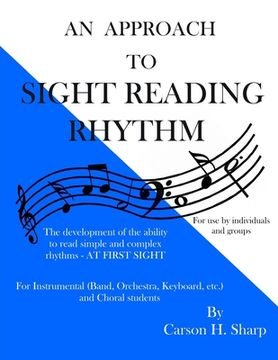Reseña del libro "An Approach to Sight Reading Rhythm (en Inglés)"
One of the most valuable skills musicians can acquire is that of being able to read at first sight all (or most) of the music they are asked to play.Sight reading is a skill that enables the student to make the most out of the time available to sing or play an instrument. The student can use the time otherwise spent on working out "rhythm" problems, to increase musicality and will be able to cover more literature. And every professional musician knows that the "musician who reads gets the jobs."It's also true that the better the members of any school or other musical group sight read, the better that group will sound. This is true for several reasons: First, more time can be spent on the development of other aspects of quality performing (sound, balance, intonation, and other general musicianship skills). Second, the time involved in reaching an acceptable performance level is less, so the music will naturally be more interesting to the performer. And this "freshness" willshow up dramatically in the concert or festival. Third, the director will now be able to use more rehearsal time to teach some of the things (theory, music history, conducting, composition, etc.) that he or she "just didn't have time for" previously. The more each student understands about music as a whole, the bigger their contribution will be to the group. Of course the greatest benefit will go to the individual student. The enjoyment of music will be enhanced considerably as a result of the skills gained in the reading of new music. It's been my experience that students, at a very young age (at least by the sixth grade) are capable of handling the concepts and skills required for effective sight reading. There are of course, several areas in which skills must be developed before a student will be able to sight read well. The skill I'll focus on in this book is rhythm. This book is an extremely effective method for helping students develop the ability to read simple and complex rhythms at first sight.The most effective way of developing the skill of instantly analyzing complex rhythmic figures is pulse subdivision. The difficulty most of us have had involves the material available to help us teach these concepts. Once the student understands what to do, practice material is needed that will help integrate each new concept into their bag of performance skills. Material is needed that will allow focus on a particular new concept without the distraction of other playing problems. Enough material is needed to avoid going over and over the same exercises. (The student can't learn to sight read if the material is familiar).The manner in which this method solves this problem is with many lines of "single pitch" exercises. These exercises allow the student to concentrate on developing particular skills without having to worry about changes in pitch, etc. There are also enough exercises so that by the time all of them are covered, the previous exercises are forgotten and can be reused if necessary.When used by instrumental organizations (bands and orchestras) or choral groups, choose a single pitch or octaves. Example: Concert FPiano students (who use their feet on pedals) can vocalize the: say 'down' on each quarter note and rest. Instrumentalists not using their mouths to generate sound can vocalize the pulse (percussion, strings, etc.). If fingers are available to generate the pulse (vocalists), use them against your leg or lap to generate the pulse.

